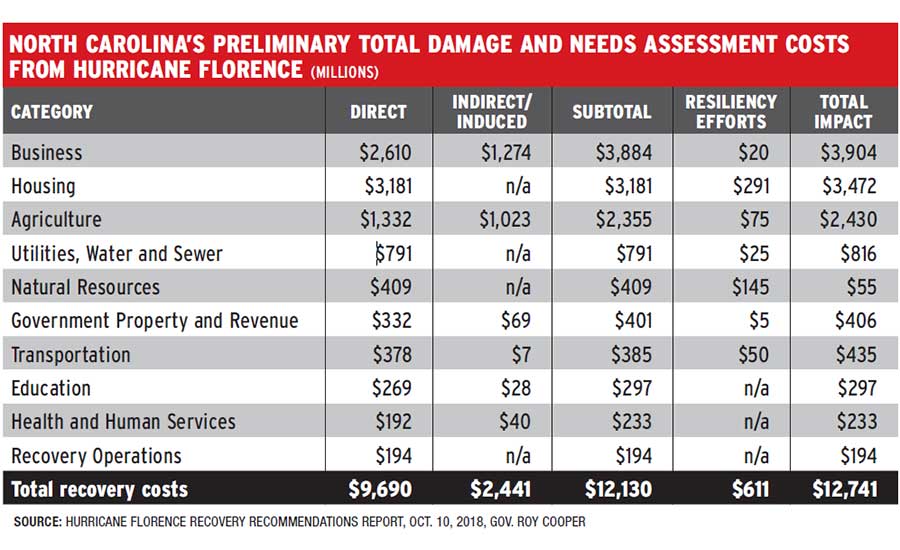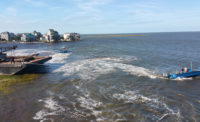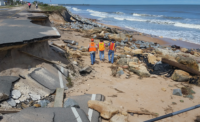The damage to North Carolina’s business and infrastructure from Hurricane Florence in early September is estimated at $12.7 billion, according to a report from the governor’s office, and the tally is climbing still.
The 77-page, detailed report was prepared by the office of Gov. Roy Cooper (D) to deliver at a special session of the state General Assembly on Oct. 15, when lawmakers approved $850 million in initial relief funding.
In addition to sector-by-sector assessments, the report discusses available funding resources and contains a number of specific recommendations, including $50 million to leverage federal grants for designing roads, bridges, pipelines and other structures to mitigate the effects of extreme weather events. Potential projects include upgrades of eastern sections of Interstate 40, southern sections of I-95, US 70 (future I-42) and US 421.
The report also calls for a significant expansion of the state’s Recovery and Resiliency office to coordinate state and federal financial assistance.
“Hurricane Florence devastated parts of our state on a scale we have never seen but we must prepare to see again,” wrote Cooper in a cover letter. Citing the two previous record-busting hurricanes to hit the state, he added: “The impact was like the damage of Hurricane Matthew in 2016 and Hurricane Floyd in 1999 put together.” He said the state “must seize the opportunity to rebuild stronger, and smarter” with more resilient buildings, roads, utilities and homes and by taking measures to move people and property out of harm’s way.
Businesses took the biggest hit, with estimated damages of $3.9 billion. More than 3,800 business properties were damaged by water and 49,000 by wind, with knock-on effects from business interruptions rippling through the state.
Approximately 1 million households suffered damages, with a preliminary impact estimate of $3.4 billion. The state’s modeling system estimates 430,000 residential structures were damaged by wind and 74,000 were flooded. Agriculture’s $2.4 billion in losses includes $117.7 million in damages to farm buildings, equipment and infrastructure.
Damage to water and sewer systems is estimated at $100 million, with a caveat that “these estimates are in the very early stages of the recovery process and will be refined as more detailed surveys and assessments are done.”
The damage estimates to the natural resources category include remediation of hazardous waste and waste management, dredging and beach renourishment, plus repairs to dams, dikes and levees.
Within the category of hazardous waste, several areas are full of unknowns, including the damage to landfills and underground storage tanks, which can float during floods or fill with water. Reports of 78 such instances have been filed so far. Three landfills are believed to have been damaged, but no releases have been reported from hazardous waste sites, according to the assessment.
Dredging and beach renourishment needs are estimated at $87.1 million and $295.7 million, respectively.
The state’s Dept. of Environmental Quality offers a preliminary estimate of $23.6 million for damage to 19 dams, including breaches at Boiling Spring Lakes and Sutton Lake, near Wilmington. Costs are expected to rise as reports come in.
After Hurricane Matthew, the city of Lumberton identified a need for floodgates and improvements to its levee, but the project has not been initiated. The city experienced extreme flooding from the same weak point during Florence. The report calls for $14 million in initial funding to resolve the risk.
The report also calls for an $88-million infusion to the Dept. of Emergency Management to improve its mapping and modeling capabilities, including $8.3 million to install additional river gauges and improve flood modeling; $32.3 million to improve LiDAR data acquisition for flood and dam-breach alerts; and $6 million to expand the state’s flood modeling to include real-time road inundation modeling, mapping and routing. The requested infusion of funds includes $36.3 million for flood mitigation studies.






Post a comment to this article
Report Abusive Comment